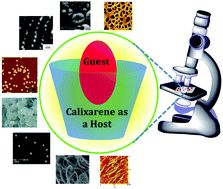Calixarene-mediated host–guest interactions leading to supramolecular assemblies: visualization by microscopy
Abstract
Host–guest chemistry, particularly of supramolecules, has been an intriguing topic for researchers for a long time due to its multiplicative applications ranging from chemical to biological to materials science. Supramolecules, such as calixarenes, are excellent host molecular systems due to their controllable cavity along with the ease of functionalization both at the lower and upper rims. The host–guest interactions involving calixarenes have been primarily studied using physical methods, such as absorption, fluorescence and nuclear magnetic resonance spectroscopy, isothermal titration calorimetry and mass spectrometry. The corresponding literature as disseminated through review articles triggered broadening of the spectrum of research. Depending upon the nature of the derivatization, the supramolecular conjugates of calixarenes have been shown to form different morphologies of micro and nanometric size as reported in the literature. Pertinent research performed in our own group was based on atomic force microscopy, transmission electron microscopy and scanning electron microscopy studies. The literature reveals that such morphologies are modified in the presence of guest species. Thus, the supramolecular host–guest complexation of calixarenes leading to the formation of various architectures has been studied using both spectroscopy and microscopy techniques to obtain complimentary data. However, there are no review articles that provide discussions on this exciting area of supramolecular science involving microscopy. Therefore, in the present article, for the first time, we have brought together the research reported in the literature during the past decade, including ours, in demonstrating the supramolecular architectures formed from the host–guest interactions extended by the conjugates of calixarenes, and their applications using microscopy. The scope of this article spans across various features of interaction in these systems: (i) in solution, (ii) at the air–water interface and (iii) on solid surfaces. The application domain includes sensing of organic explosives and drugs, exhibiting antibacterial activity, supramolecular self-assembly or co-assembly resulting in gels, micelles and vesicles, and the consequent aggregation-induced emission and a few others.

- This article is part of the themed collection: Host-Guest Chemistry


 Please wait while we load your content...
Please wait while we load your content...